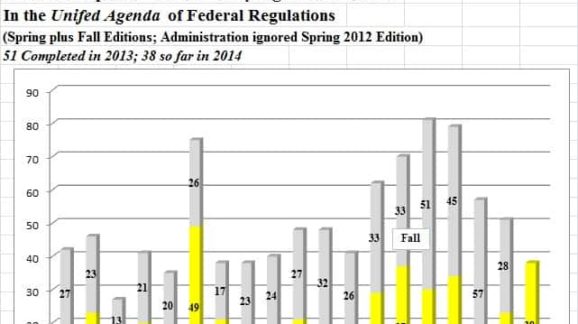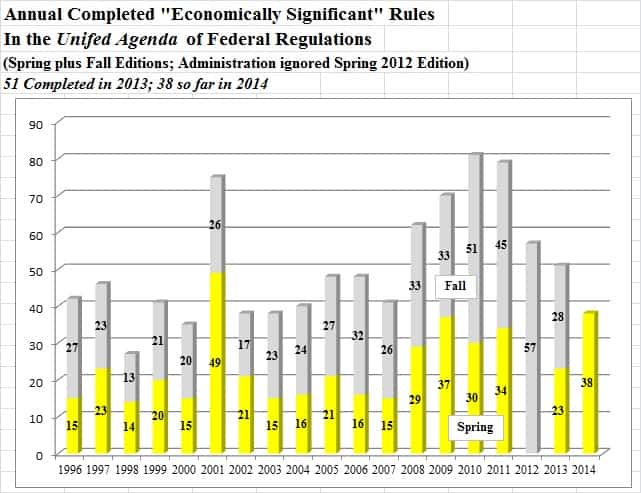Red Tapeworm 2014: Completed Economically Significant Rules at Record Levels

This is Part 21 of a series taking a walk through some sections of Ten Thousand Commandments: An Annual Snapshot of the Federal Regulatory State (2014 Edition)
We’ve noted that there are 191 high-cost “economically significant” rules scattered among the 3,305 rules in the Unified Agenda of Federal Regulations. These represent a decrease from the year before, but they still carry on a level higher than what prevailed during the early part of the 2000s.
Each economically significant rule has annual impact of at least $100 million, so those rules might be expected to impose annual costs of at least $19 billion when finally implemented (191 rules multiplied by the $100 million economically significance threshold). A full list of these 191 rules may be seen in Appendix: Historical Tables, Part G in Ten Thousand Commandments.
The $19 billion likely represents a floor, although economically significant rules can sometimes reduce costs. Moreover, it each represent not a one-time cost, but a recurring annual cost to be added to prior years’ costs cumulatively. Nor are agencies legally limited to the regulations they list in the Agenda.
The chart nearby isolates the totals of Completed” economically significant rules from 2013’s spring and fall Agendas for closer analysis.

One can see that total Completed economically significant rules annually are down substantially in 2013 from the 2010 peak—from 81 to 51. (The 2014 Spring Agenda has brought another 38.)
Nonetheless, like the overall number of economically significant rules we looked at last time, the flow from 2008 forward is considerably higher than the earlier part of the decade (except for the year 2001). The chart reflects the fact that only one edition of the Agenda appeared in 2012, thus making comparisons murkier.
The fact that policy makers and analysts pay the most attention to economically significant rules should not seduce them into ignoring the remaining bulk of rules in the yearly pipeline, yet it does.
In 2013, 3,114 federal rules were not designated as economically significant by the government (3,305 total rules minus the 191 economically significant ones).
Many of those rules are economically significant in the ordinary sense of the term, not matter the government’s failure to classify them as such. A rule can cost up to $99 million and escape the official “economically significant” designation.
Next time we’ll take a closer look at rules impacting smaller businesses.
2014 Red Tapeworm Series:
- Part 1: Guess Which Is the Largest Government on Earth?
- Part 2: Tardy Bureaucrats Gone Wild
- Part 3: Reckoning the Dollar Cost of Federal Regulation
- Part 4: Regulations Catching Up to Government Spending?
- Part 5: Regulations Cost More than Federal Income Taxes
- Part 6: The Federal Government “Eats” 31 Percent Of The U.S. Economy
- Part 7: U.S. Regulation Compared to the World’s Largest Economies
- Part 8: The High Cost of Overcriminalization
- Part 9: Thousands of Federal Register Pages
- Part 10: A Record Number of Federal Register Final Rule Pages
- Part 11: Federal Register Pages Per Decade
- Part 12: Number of Proposed and Final Rules In the Federal Register
- Part 13: Cumulative Final Rules in the Federal Register
- Part 14: The Expanding Code of Federal Regulations
- Part 15: A Fourth of July Reflection on Presidential Executive Orders and Loss of Liberty
- Part 16: Over 24,000 Pen and Phone “Public Notices” Annually
- Part 17: When Regulations Get Delayed
- Part 18: Federal Regulatory Disclosure Becomes More Confused
- Part 19: Federal Regulatory Agenda Consistently Tops 3,000 Rules
- Part 20: Here Are the Federal Agencies that Issue the Most Regulations
- Part 21: Big Dollar Federal Regulations in the Pipeline Highest Under Obama